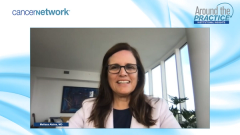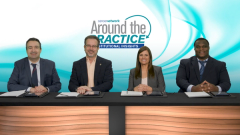
Selection of Induction Therapy in Patients With Transplant-Eligible NDMM
Shared insight from experts in multiple myeloma on the real-world utilization of induction therapy and transplant for patients with newly diagnosed disease.
Episodes in this series

Transcript:
Melissa Alsina, MD:You mentioned the importance of the monoclonal antibodies. So if you see a patient with newly diagnosed myeloma right now, that is eligible, based on this data, what is your induction therapy of choice?
Ken Shain, MD, PhD: So when I think, when a patient walks into my office, or my clinic, and I say newly diagnosed transplant eligible, and again a critical comment is—transplant eligible to me, is different than it was for IFM [NCT01191060] and DETERMINATION [NCT01208662] studies. For anybody less than 75 years old, I am already thinking about if they’re fit, etc. But that sounds like 4-drug therapy. I’ve fully integrated monoclonal antibodies, daratumumab [Darzalex], specifically, into my upfront therapy with lenalidomide [Revlimid], bortezomib [Velcade], and dexamethasone as an induction to be followed by transplant, and then the consolidation vs straight to maintenance is always going to be risk-adapted in my opinion. That’s how I kind of look at an individual who walks into my clinic. Again, MRD [minimal residual disease] negativity before transplant is a really intriguing thing for us to make decisions on. I would say that I don’t make that a rule; it’s going to help patients decide if they don’t want to do that. It’s something that’s not wrong, but I think I want to give them maximum therapy. I want to think about that 3-step process, induction, transplant, and then risk-adaptive maintenance therapy. I think a little bit about consolidation sometimes, depending on the response.
Melissa Alsina, MD: Right, so Rachid, is there a patient that—I am not saying that you agree with Ken—but is there a patient that you would select Dara [daratumumab]-KRd [carfilzomib [Kyprolis], lenalidomide, and dexamethasone], instead of Dara [daratumumab]-RVd [lenalidomide, bortezomib, and dexamethasone].
Rachid Baz, MD: Yes. I think there are a couple of studies that have looked at Dara [daratumumab]-KRd other than the MASTER [NCT03224507] study. I think the IFM 2018 as well, has looked at Dara [daratumumab]-KRd in high-risk patients. The data is intriguing; I think the main thing that we have to look at is the difference in the adverse effect profile of carfilzomib and bortezomib. If you go back to [the] ENDURANCE [NCT02297204] study, comparing to KRd and VRd [bortezomib, lenalidomide, and dexamethasone], both studies in the standard risk patients with (4;14) translocation included had very similar outcomes, but there was differential toxicity. So if a patient comes in with existing neuropathy but no cardiovascular risks and this is a patient, for example, that Dara [daratumumab]-KRd or KRd, could be a very reasonable induction, vs a patient who comes in otherwise everything else is equal. I think I would say Dara [daratumumab]-VRd would be maybe the backbone that I would use. And I would agree we scan. I think maybe I am less of a fan of consolidation post-transplant. A lot of our practice hasn’t really followed exactly the GRIFFIN [NCT02874742] design, where there was initial induction that was time limited. We generally treat until best response and at that point, I don’t know what the role of post-transplant consolidation really is, because we’ve usually given a longer induction as a general rule.
Melissa Alsina, MD: Brandon, how would you describe the role of transplant in newly diagnosed myeloma based on this data that we have discussed?
Brandon Blue, MD: I think that really brings into question, that maybe we can treat patients on an individual basis, and really not treat all patients the same. We can actually look sometimes at the response that the patients actually get from the upfront treatment, but sometimes determine what’s the next best step. I think there’s still more information to know exactly, which patients should or should not be transplanted. But I think if you come in with a newly diagnosed patient and you think this patient is transplant eligible, No. 1, a referral should take place, because the referral is just for us to determine if this patient is meeting some of those qualifications. But then actually proceeding with transplant, I think sometimes it’s still yet to be determined. I think it still may be more information to be told, if someone does obtain MRD negativity, then you say well, what benefit may this patient get from the transplant? I think those are some questions that are still yet to be answered. I would say that right now, I think that the role of transplant is still there, and we still see from some of the data that was presented, that we do see that PFS [progression-free survival] benefit is still there. However, it may be for all patients, and so I think that’s where more information and more data really need to come out. Who are those patients that sometimes can maybe forgo transplant and actually still obtain the same level, or even better progression-free survival?
Rachid Baz, MD: Yes. I think I would completely agree, as I think transplant is still the standard of care for patients who are eligible. I think we should be careful not to read too much into the subgroup analysis of the DETERMINATION study because, for example, there were fewer benefits seen among African American patients. There was also less benefit seen in ISS [International Staging System] 3 stage, but still a good, very good benefit seen in high-risk patients that are cytogenetically defined. How do we put it all together? Is there a way that we can explain that biologically? At this point, we don’t have all the answers. And it’s a subset analysis I think. I don’t think that changes the discussion for all those patients.
Melissa Alsina, MD: OK. So the last point I think that we should make for this patient population is when you treat a patient you decide induction, like quadruplet induction or transplant maintenance, what is your goal of therapy? What are you looking for? Are you trying to get this patient to MRD negativity? Are you trying to achieve a CR [complete response]? How do you determine how long you are going to keep these patients on treatment?
Ken Shain, MD, PhD: I think I’ll start first with maybe the low-hanging fruit, which was what was our goal of therapy? I think on a high level it’s to kill as many bad guys as we can, and so to me, that means MRD negativity, which is the best test we have in terms of depth of response. And again, it means not just 1 test. It’s imaging. It’s bone marrow. It’s light. It’s all, etc. But MRD negativity should be our goal for therapy. Well, let’s all be realistic, and say that not all patients are going to achieve MRD negativity, right? It should be the goal, but we’re not always going to get there. We don’t know if forcing them to get there is the right answer. But I think that kind of staggered approach to induction therapy, transplant, and maintenance gives us further options to get us there. Including maintenance therapy, going to improve by 20%, so even with just Len [lenalidomide] maintenance. I think, to me the first 1 is yes; MRD negativity is the goal. Length of the therapy, if you tell me induction, I try to treat. Traditional seems 4 cycles—I kind of tried to hit 6, but if they’re still responding really well, if I get even closer before transplant, I think that’s better. And as Rachid mentioned, maybe you don’t need as much consolidation on the backside because you’re getting more when they’re tolerating it very well before transplant. And then maintenance therapy really, I tell patients, we stopped maintenance therapy for 3 reasons: 1—progression, which we don’t want to talk about; 2, toxicities that we can’t fix and control; and 3, financial toxicities because, unfortunately, these drugs are extremely expensive and no human being can pay for these without insurance, our grants, etc. That’s kind of how I look at it, and I don’t know if you guys want to add or comment or feel differently, but that’s how I think about it.
Rachid Baz, MD: No. I completely agree. I think, a lot of times I try to hold off on saying that my goal is MRD negativity, but my goal obviously is the same—to get rid of as many plasma cells as I can. But also I have to be mindful of the adverse effects the patient will encounter. If a patient is responding nicely, and hitting certain landmarks, VGPR [very good partial response] by transplant, will I change therapy if the patient doesn’t reach MRD negativity? And the answer is absolutely not. So yes, of course, I would be happier if the patient is MRD negative, but on the other hand, I don’t think we have data to this point to change our approach if we don’t get MRD negativity. Some patients may not get there with the therapies we have available today, but I think we have to be mindful also of the toxicity the patient encounters. And I think that the pandemic has taught us that infection is something to be particularly aware of. We do lose patients to infections, so we do have to be particularly careful about that one as well.
Brandon Blue, MD: The only other thing I’ll add, too, is that sometimes you can make things up on the back end with how your maintenance strategy is going to be. So not everyone post-transplant gets into MRD negativity, and then you can make a decision on that, on the backside, and say, “Well, what am I going to do now? What options do I have?” I think that still gives you some freedom to be able to send them to transplant but still give them some great therapy on the back end.
Ken Shain, MD, PhD: One last comment, I apologize. You call it MRD negativity, MRD, but there are patients who have an M-spike [monoclonal spike] and they do very, very well. And I can think of multiple patients, who are on maintenance, or stop maintenance, will have a measurable M-spike and they’re still doing just fine. It’s not for everybody. The goal doesn’t mean everybody has to achieve it. It’s just a goal for therapy.
Melissa Alsina, MD: Nodefinitely, we need to look at the patient. Maybe, for example, we’ll push more in patients that have high-risk disease, because in those patients it’s more important to get them to that minimal residual disease negative status, or at least a CR, right? And then with the standard risk patients we may not be as aggressive.
Transcript edited for clarity.
Newsletter
Stay up to date on recent advances in the multidisciplinary approach to cancer.






































































































